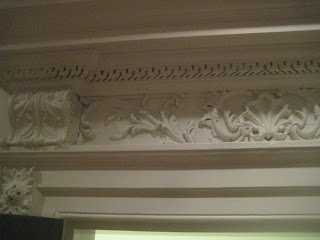The Chestertown Room 1771
I have been fascinated with Antiques & Period rooms since I was very young. I thought at a young age “One day I will live in a home set up with period rooms full of antiques. I now do, But I still love visiting them in Museums, House museums and peoples private historic homes. Today I will share with you photo’s of the beautiful Chestertown Room set up at the Baltimore Museum of Art.
The room is elegantly furnished with Maryland and Philadelphia
I was in Baltimore Baltimore Museum Baltimore
The upper section of the chimneypiece with a imposing pedimented tabernacle frame with carved acanthus leaf scroll appliqués in the architrave, and floral and leaf rosettes in the corners of the crossetted frame. The richly carved floral margents hanging on each side of the tabernacle frame and suspended from ribboned bows, are carved separately and attached with nails to the chimneypiece are from designs found in Thomas Johnson’s New Book of Ornaments publish in London in 1762
The Chestertown Room was installed in the Baltimore Museum of Art in 1932. It was taken from the Ringgold House on Water Street in Chestertown , Kent
The portrait is of Thomas Ringgold painted by Maryland Artist Charles Willson Peale. Ringgold was one of a group of Marylanders who had financed Peale's art studies in England.
The original house was built by Dr. William Murray about 1743. A rear wing was added to the house soon after it was bought by Thomas Ringgold, Sr. in 1767. After a study of Maryland ’s 18th century architectural chimneypiece and interior doorway carvings it is thought that the Chestertown rooms carvers technique are similar to well-known Philadelphia Philadelphia
The room is elegantly furnished with Maryland and Philadelphia
Chestertown is only 70 miles down the road from Philadelphia so the woodwork in the Chestertown room could have also been imported from Philadelphia Philadelphia
The richly carved floral margents hanging on each side of the tabernacle frame and suspended from ribboned bows, are carved separately and attached with nails to the chimneypiece
The beautiful delicate carved elements in the Chestertown room are the consoles and architraves of the entablatures over the doors, the upper section of the chimneypiece with a imposing pedimented tabernacle frame with carved acanthus leaf scroll appliqués in the architrave, and floral and leaf rosettes in the corners of the crossetted frame. The richly carved floral margents hanging on each side of the tabernacle frame and suspended from ribboned bows, are carved separately and attached with nails to the chimneypiece are from designs found in Thomas Johnson’s New Book of Ornaments publish in London in 1762, as well as other elements within the room.
The top part of the rooms chair rail is mahogany
The original doors in the room retained there original Mahogany stain as well as there silver plated brass knobs and escutcheon plates. The locks are mortise rather then rim locks, and unusual feature for the period. The top part of the rooms chair rail is mahogany. The colors of the room or the original colors.
The room is elegantly furnished with Maryland and Philadelphia
In May of 1773 en route to New York Annapolis at Chester Town U.S.
Around the fireplace surrounds in the room is Pennsylvania King of Prussia marble a fashionable Philadelphia
The beautiful delicate carved elements in the Chestertown room are the consoles and architraves of the entablatures over the doors
The beautiful delicate carved elements in the Chestertown room are the consoles and architraves of the entablatures over the doors


























One of my favorite things about big museums are the period rooms. Richard from My Old Historic House
ReplyDeleteI am with you... I have loved visiting museum rooms and old houses since I was a kid... always have thought and do still think they are magic. It's so important to get the sense of the whole to get an idea of the way they lived.
ReplyDeleteI'm sure it was by visiting natural history museums in Detroit and Chicago that nurtured my current love for classical buildings, too. Great entablature pictures!
ReplyDelete